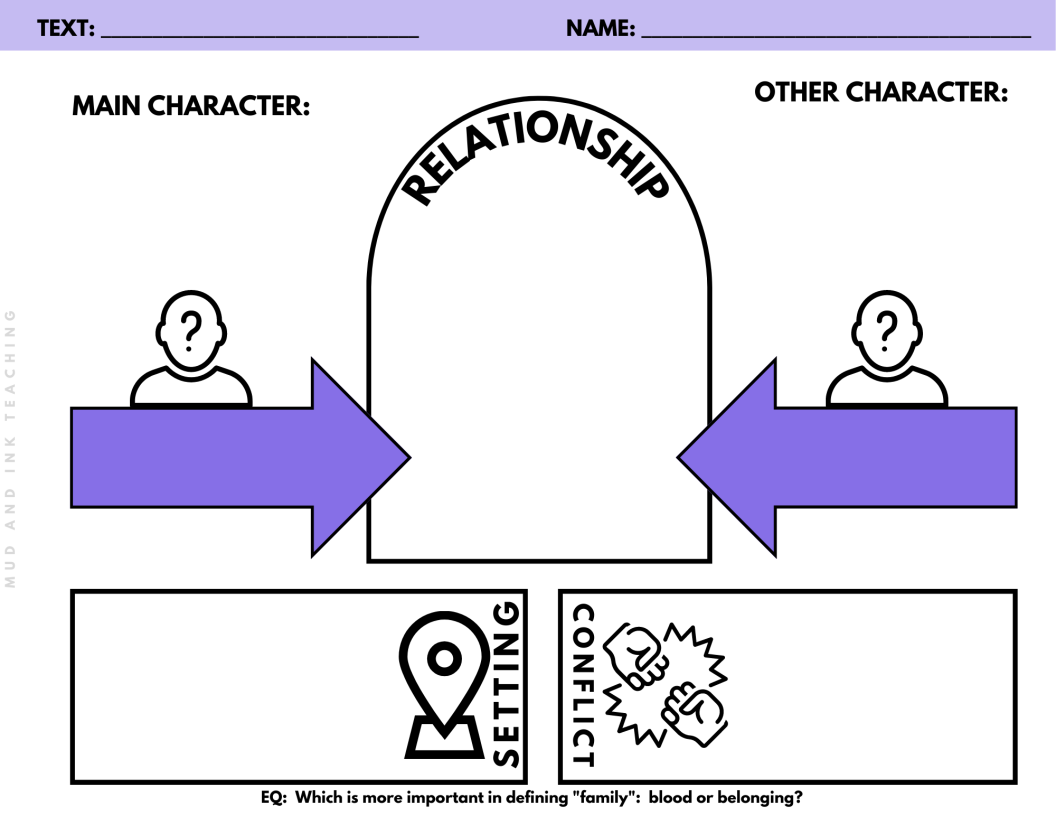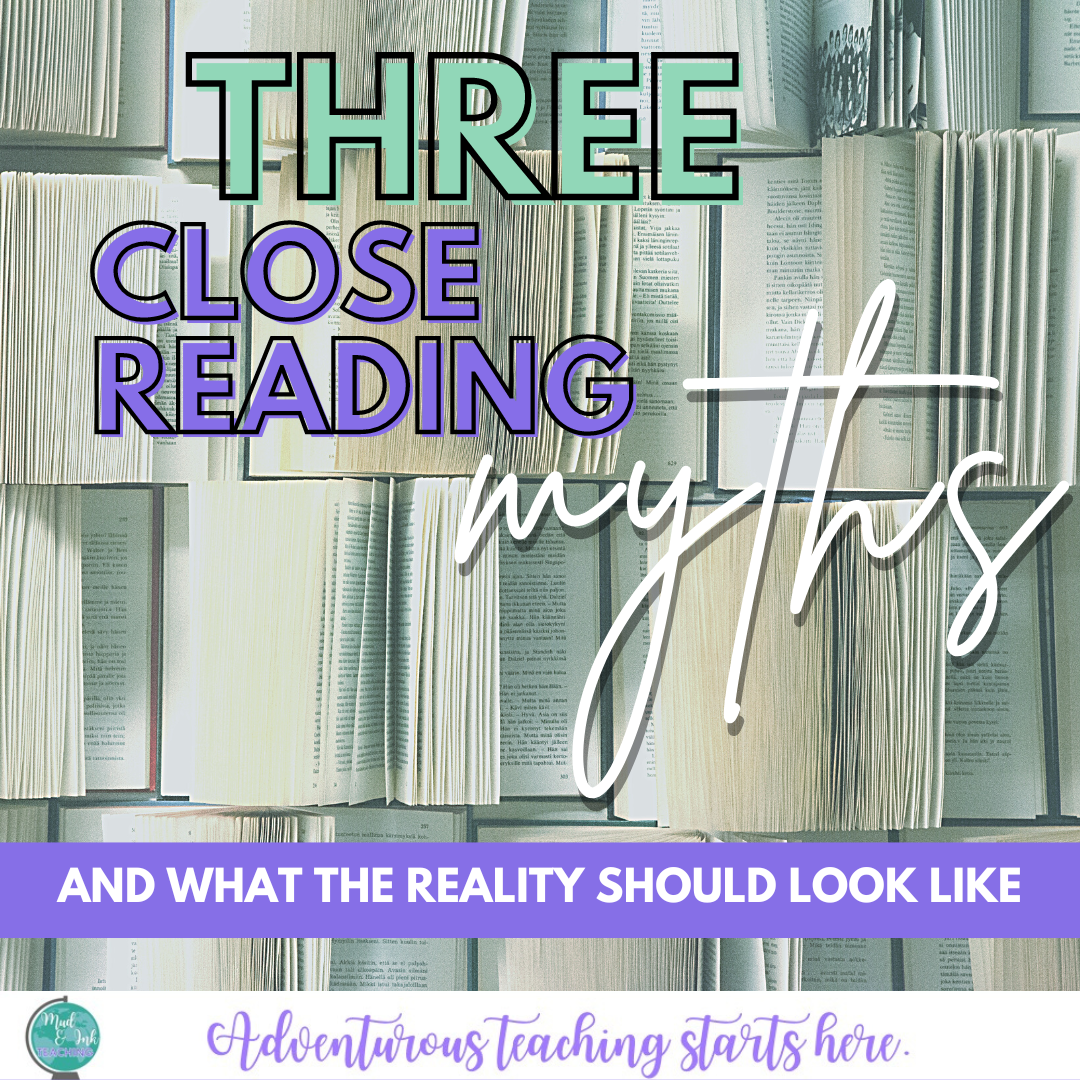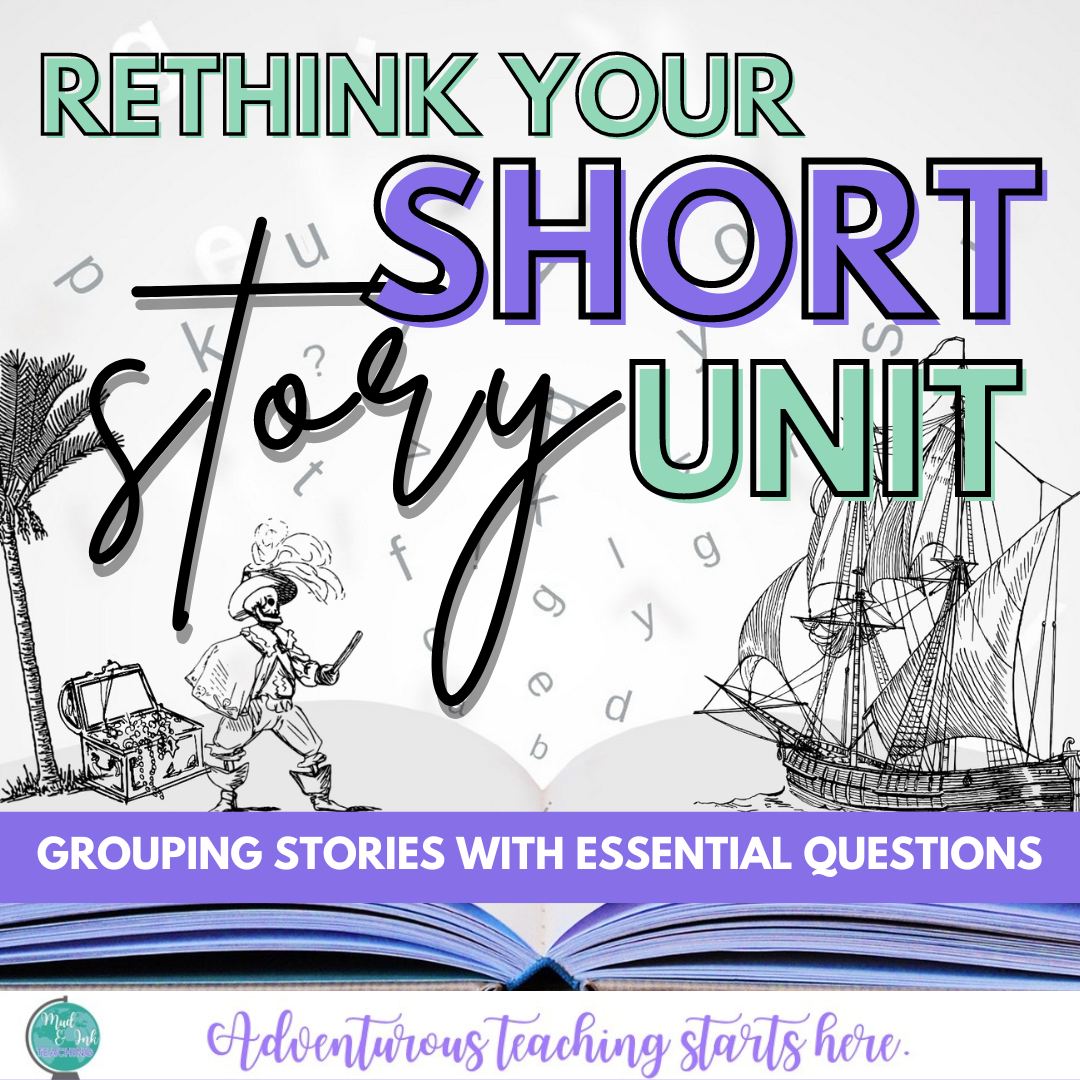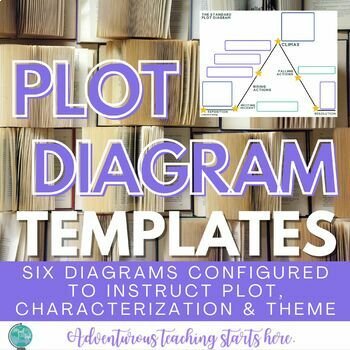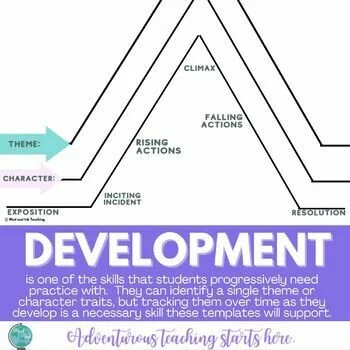
ADVENTUROUS TEACHING STARTS HERE.
Teaching Short Story Units with a Modern, Contemporary Twist in Secondary ELA
If you’ve ever found yourself searching the internet for “contemporary short stories” or “modern short stories” because you’re tired of teaching the same classic stories over and over again, I have THE HACK to change everything for you!
If you’ve ever found yourself searching the internet for “contemporary short stories” or “modern short stories” because you’re tired of teaching the same classic stories over and over again, I have THE HACK to change everything for you!
I won’t even make you wait until later to hear my little secret. I’m just gonna spill the beans :)
Stop searching for short stories and start teaching NOVEL EXCERPTS!
THE BENEFITS OF USING NOVEL EXCERPTS
Let’s get something clear from the get-go. This blog post is not advocating for exclusively teaching excerpts all year long. Some context here is very important: my suggestion is to use novel excerpts to update the outdated short stories that we find anthologized so frequently. This is a suggestion for the teacher in a short story unit rut that wants more voices, more styles of writing, and something that’s both easily accessible and FREE. Almost all of our favorite YA and adult novels have sample chapters available online, oftentimes directly from the publisher’s website.
All this is to say, we NEED full-length works in our curriculums. But that is a blog post for another day and not what you came here for. So let’s proceed.
DIVERSE VOICES
When we talk about the kinds of texts our students need, the conversation should always come back to representation. Are the life experiences, family dynamics. racial histories, gender identities, and other ways that make our students’ lives unique and important need to show up in the stories and protagonists that we include in our curriculum. Using publisher’s websites and Goodreads is a great way to research titles for the voices that you think your short story unit is missing. Once you’ve found a title, search the novel title and the word “sample” or “excerpt” in Google, and more likely than not, you’ll come up with a result!
Not all excerpts are created equal, of course, so read through what you’ve got and make a call.
Need more insight on representation and our classroom libraries? Check out this guest post from my friend John Rodney about inclusive LGBTQ+ stories and protagonists.
2. VARIED WRITING STYLES & GENRES
Here is another thing that is easier to search with novels as opposed to short stories: searching by genre! So often I see teachers lumping a bunch of stories together and naming their unit the “short story unit”. In this case, all that the stories have in common is that they’re, um, short? Not novels? So thinking through the idea of genre, not only can we find stories with general commonalities, but it sets us up nicely the opportunity to build Essential Questions.
3. FREE, HIGH-QUALITY TEXTS
I love book shopping just as much as the next English teacher, but when it comes to picking up anthologies, skimming the table of contents, and then reading each and every story, it can become a cumbersome task when rewriting a unit. Is it worth it? Absolutely — but only if you have the time and the budget. If you’re out of time and have zero budget, follow the tips above and start with your favorite novels that you think speak to each other. Start layering your excerpts underneath the umbrella of an Essential Question until you have a rich, varied, interesting, and most importantly, FREE brand new set of texts.
TWO SHORT STORY-EXCERPT UNITS TO TRY
If the above info was enough for you to take this idea and run with it, by all means, go and run! But if you’re wishing that you had a model to look at before getting started, I have two units to share with you here. I’m happy to share the gist and outline with you here, and if you’d like to purchase either, they’re only $8 each in my TpT store.
START WITH YOUR ESSENTIAL QUESTION
To me, this is the most vital part of the short story unit makeover. Units that are driven by inquiry and curiosity beyond the texts provided create a natural engagement that’s hard to achieve otherwise. So here are two EQs that I’ve used with short story units:
Which is more important in defining "family": blood or belonging?
Through which lens is it better to view others: trust or skepticism?
Each of these questions sets up an interesting task for the creator (you!). What kinds of voices can I find to shed light on this question? What are the various branches that lead back to this EQ? How can I share a variety of perspectives and experiences across time, gender, race, ethnicity, and genre? Or even — would one of these questions set me up to explore various ways of exploring one genre?
BUILD YOUR TEXT SET
So for the first question about family, I decided to treat this text set thematically: each text will offer a different perspective on the idea of what makes a family a “family”. I started with a few novels that came to mind right off the bat: Where the Crawdads Sing by Delia Owens, Far From the Tree, and . To find a few more, I went to Goodreads and searched “family”. After reading a few summaries and checking out their corresponding excerpts, I decided that Take Me With You When You Go by David Levithan and Jennifer Nevin and From Here by Luma Mufleh would be a perfect fit. This grouping offers us fiction, memoir, multiple narrator style storytelling, a novel in verse, a story about pregnancy and adoption, a refugee perspective, and so much more. No matter how different and varied these stories are, they all come back to the same thread: how do we define family?
For my other question, I had in mind a mystery and suspense genre focus even before writing the EQ, so I knew I wanted to have the texts be connected by genre. I pulled a few thrillers, a few mysteries, and was sure to include a YA crowd favorite: One of Us is Lying. My complete text set list includes excerpts from:
One of Us is Lying by Karen M. McManus
Monday’s Not Coming by Tiffany D. Jackson
The Box in the Woods by Maureen Johnson
In a Dark, Dark Wood by Ruth Ware
The goal of this particular unit is to give students the opportunity to explore the genre of mystery and thriller while trying to find out what these kinds of stories tell us about how we should approach our own view of the world.
BACKWARDS PLAN YOUR UNIT
With short stories, it’s important to backwards plan the same way we backwards plan any other unit. Here are a few questions to ask yourself as you sit down with your planner (I use Artful Agenda: a pretty, digital planner that syncs up with my Google Calendar):
What is your goal for this unit?
What should students be able to do by the end of this unit?
What assessment tool will be used to measure students at the end of the unit?
What can I use regularly during this unit to give students plenty of practice?
Which skills need direct instruction and which need review and practice?
The true danger of any unit is trying to plan starting with day one and forgetting about the end until you get there. Short stories can take a surprisingly long time to read and discuss, so by backwards planning, you can avoid being blindsided by your own story selections (I’ve been there — “The Lottery” and I have a long history of ups and downs). In my short story units, I plan backwards using templates (similary types of lessons on repeat). Every unit I teach must have:
A gateway activity (something to spark curiosity and get them excited about the EQ)
An anchor tool (a graphic organizer or handout that is used on EVERY short story to help students focus on the most important skills of the unit)
Formative assessments
Summative assessment
From that starting point, I begin to fill things in little by little keeping in mind the realistic pace that I’d like the unit to have.
MORE SHORT STORY UNIT IDEAS
My co-host of the Brave New Teaching podcast, Marie Morris, has a wonderful short story unit that’s entirely made up of folktales and fairy tales. She walks through the unit in this episode here:
Are you excited about the idea of threading together your short story unit with Essential Questions? I have an entire blog post dedicated to even more ideas for EQs and text set suggestions. Check it out here!
LET’S GO SHOPPING!
Unit Makeover: The Short Story Unit in Secondary ELA
Short story units have the potential to deeply inspire and impact learning with students, but if the approach is disjointed or lacking any sort of alignment, these units can feel like flops. Here are the ways that I craft meaningful, engaging, and interesting units to highlight the short stories that we love (and a few more that we should add to the rotation!)
Unit Makeover: The Short Story Unit in Secondary ELA
When is the last time you sat down for a meal where your server recommended a very specific bottle of wine to match the meal you were considering on the menu? The perfect Argentinian Malbec to compliment the perfect marbled ribeye. And when is the last time you tasted that symphony of flavors? The melting, fatty salt of the meat on your tongue is followed by the gentle swirl of the deep red wine just after.
Maybe you’re a vegetarian and ready to never come back here and read another article from me again, and I understand (this is not the first time that I’ve used a metaphor about meat. Hmmm…), but if you’re willing to hear me out, here it is:
Disjointed experiences are fine, but intentionally, purposefully blended ones are so much more memorable.
This is precisely how I feel about unit planning and especially the notoriously predictable plan that every English teacher since the dawn of time seems to design: UNIT 1 - SHORT STORIES.
THE DISJOINTED SHORT STORY SCENARIO
The idea for this unit seems logical on paper: start the year with some shorter texts to warm back up, review everything students need to know for the year coming up, and presto! Ready to take on the year. But after experiencing this myself and talking to hundreds of other teachers, there are a few notable problems:
PROBLEM 1: Lack of connection
Short stories don’t naturally connect to one another just because they are short stories. So when we begin these units thinking about the skill review component, we are often blindsided as the unit is in progress feeling like it’s clunky and lacks flow. Without the feeling of connection, these units can be difficult to navigate in terms of pacing and engagement.
PROBLEM 2: Lack of representation
The most commonly anthologized stores also tend to be Euro-centric, male-authored stories. We have a responsibility to do better for our students and to have their own voices, stories, backgrounds, and experiences represented and included in everything we do. This means branching outside of the short stories most frequently recommended by text book companies and doing some of our own research to find new, fresh voices.
PROBLEM 3: Lack of variety
One teacher wrote to me saying: “I do run into trouble when I try to use short stories that are available on CommonLit. When I've tried to use them in the past--some are amazing short stories, like "The Landlady" and "The Intepolers"--the kids complain that they've already read them! UGH”
Does this sound familiar? Since starting the year this way is so popular and databases like CommonLit have come around, teachers sometimes find themselves going to the same places for ideas and then repeating stories.
PROBLEM 4: Trying to cover too many skills
Sometimes the nebulous goal of “reviewing literary terms” stretches student focus too thin. Attempting to use one single unit to cover a dozen or more terms ends up giving us more attention to breadth rather than depth.
Specific EQ Unit & Text Set Pairings:
To solve many of these problems with the traditional short story unit, I recommend implementing an Essential Question to drive the unit. Short stories need to be contextualized, and using an Essential Question connects the dots and creates meaning. The art of writing an essential question takes into consideration three key components: text(s), themes, and skills. Essential questions should drive genuine curiosity and be exciting for students to explore, discuss, debate, and return to throughout the year.
Below, I’ve drafted a few examples of EQs that could theoretically be used at the start of a school year. You’ll notice a few things:
The question anchors the unit. From introducing the question to assessment, the question is the driving force that connects all texts and activities.
Instead of teaching short stories and a variety of random literary terms, the unit is cohesively driven by a more narrow focus.
The EQ gives direction for the unit without being prescriptive. The suggestions I have here are flexible and adaptable to different grade and difficulty levels.
In each of the example units below, I’ve provided a mixture of the most commonly used short stories that you may have from anthologies or prescription curriculums blended with new ideas, short film, music, and other genres to further address the complexity of the EQ. Be sure to check out Episode 107 of the Brave New Teaching Podcast to see how this method was applied in Marie’s class!
Here are a few example ideas to get started:
Example #1: Connected by a skill/standard
Unit 1: Is conflict more likely to make our lives better or worse?
Skill Focus: The shape and arc of stories
Plot diagram components (with emphasis on conflict)
Exposition, inciting incident, rising actions, climax, falling actions, resolution
Vonnegut’s The Shape of Stories
Internal VS External Conflict
Three classical types of conflict: “man vs man”, “man vs. nature”, “man vs himself”
Text Set:
Buzz Lightyear Internal Conflict - You are Just a Toy: Scene 1 & Scene 2
All American on Netflix Episode 1
Assessment:
Skill Focus: Cold Read & Written response based on conflict
EQ Focus: Synthesis argument writing answering the EQ (utilize personal experience and texts from the unit to answer EQ)
Example #2: Connected by genre
Unit 1: To what extent does gothic fiction reveal the human condition?
Skill Focus: The elements of gothic fiction
Author’s use of tension
Author’s use of tone/mood
Setting
Text Set:
Excerpt from Mexican Gothic by Sylvia Moreno Garcia
Various scenes from The Phantom of the Opera
Assessment:
Skill Focus: A project-based assignment where students analyze the connection between tension, mood and setting (a recreated scene and written analysis; a living tableau; an artistic interpretation)
EQ Focus: A literary analysis writing that hones in on one of the stories and the gothic elements that reveal the human condition
Need to teach plot elements?
Example #3: Connected by another genre
Unit 1: How does dystopian fiction use the present to predict the dangers of the future?
Skill Focus: The elements of dystopian fiction
Characteristics of a dystopian protagonist
Author’s use of tone/mood
Setting
Imagery
Text Set:
“There Will Come Soft Rains” by Ray Bradbury
“The Lottery” by Shirley Jackson
“Harrison Bergeron” by Kurt Vonnegut
“The Ones Who Walk Away from Omelas” by Ursula K. LeGuin
Assessment:
Skill Focus: Cold Read & Write: How does the author’s use of genre elements / setting / imagery / use of tone/mood in order to warn about the dangers of the future?
EQ Focus: Research project: select a present problem and predict the dystopian future to come from this issue
Example #4: Connected by a theme
Unit 1: Which is more impactful in a child’s coming of age: the influence of family or the physical environment around them?
Skill Focus: Elements of coming of age genre
Setting
Characterization (direct & indirect)
Text Set:
Assessment:
Skill Focus: One Pager - Choose one character to place at the center. Surrounding the character, add evidence of coming-of-age moments, setting, etc. that have influenced their development
EQ Focus: Synthesis Argumentative essay responding to the EQ using the short stories from the unit
Example #5: Short Stories Reimagined in Fairy Tales
In episode 107 of the Brave New Teaching Podcast, I chat with my cohost Marie Morris about the process of tackling a unit makeover with short stories. Listen in to see how we resolved so many of the problems (at the top of this post) and built a Fairy Tale Unit that completely revamped the level of engagement while still tackling all of the skills that mattered the most.
No matter how you tackle your unit makeover, consider the power of that Essential Question to give the context your unit needs. I’d love to hear how you tackled your own makeover, so be sure to leave a comment below!
TRY AN EQ ADVENTURE PACK!
These units are packed up and ready to teach! They are seamlessly aligned with a juicy Essential Question, supplemental texts, and plenty of templates to use in tandem with whatever short stories or novels you have on hand. Check them out right here!
